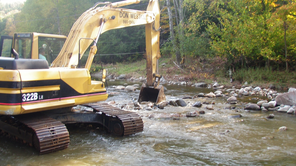Tropical Storm Irene: How Do We Respond?
October 2011
First in a Two Part Series
Tropical Storm Irene will shape our thoughts about and relationship with rivers for at least a generation. A previous generation reacted to the floods of 1927 by straightening and berming rivers and dredging sediments. Bulldozers ran down the rivers shoving stones aside.
Two generations after that storm we began to see the folly of our forerunners’ response. Rivers cut deeper channels, losing access to their floodplains and becoming chutes that delivered sediment and pollution to Lake Champlain for decades. Fish habitat pushed aside by the bulldozers never reappeared. We developed a sense of complacency about the power of rivers to recover their channels and we rebuilt in the floodplains. Will we learn from our predecessors mistakes in recovering from this storm or repeat them?
It is understandable that town officials, presented with a localized in-stream problem will search for an immediate solution. However, their failure to understand downstream implications of their actions can create later problems. A typical short-sighted response to flooding is removal of gravel from steam beds. Inevitably floods deposit extensive quantities of gravel in certain sections of streams. Removing the gravel without careful attention to downstream impacts can create significant problems. If too much gravel is removed the elevation of the stream bed is reduced. As water flows into the lowered portion of the streambed it creates an area of active erosion that over time works its way upstream. As the streambed drops, the stream section that used to be an area of sediment deposition now becomes a transport chute. The sediment that would have been dropped out of the water does not disappear but continues downstream to become someone else’s problem. Straightening a stream has the same overall effect.
The shape of any river evolves over time in response to four variables: the size of sediment particles, the quantity of sediment, the amount of water in the stream, and the slope of the stream. If any of these variables change then the stream adjusts to bring itself back into a dynamic equilibrium. For example, if the volume of water in a stream increases, as it did during Irene, the quantity or size of sediment moved increases, causing erosion. Additionally, the slope might decrease as the river jumps across meanders, shortening the distance traveled down a given elevation. Once the floodwaters recede the additional sediment added falls out and the course of the river may change.
Flooding allows rivers to reclaim floodplains lost to encroachment. Between floods, people view flatter floodplain areas as ideal places for homes and businesses. Construction in the floodplains begins to constrain the rivers. Then when the inevitable next flood does come, it brings extensive property damage.
Bridges and culverts also constrain a river’s response to natural conditions. They force the river to move through a defined point when its natural inclination might be to wander. The river begins to act like a snake in your hand, thrashing wildly back and forth wherever it’s not confined by your grip.
Vermont and New York are short-circuiting rules for gravel removal and stream alteration in response to the disaster created by Tropical Storm Irene. By doing so, they allow alterations in areas where homes, roads, or bridges were immediately threatened. However, relaxing the rules also provides an excuse to undertake projects beyond the scope of the emergency rules, not recognizing how the actions will ripple downstream. It is incumbent upon our local and state officials supervising in-stream work to ensure that the problems they create are not worse than the problems they are trying to solve.
Lake Look is a monthly natural history column produced by the Lake Champlain Committee (LCC). Formed in 1963, LCC is the only bi-state organization solely dedicated to protecting Lake Champlain’s health and accessibility. LCC uses science-based advocacy, education, and collaborative action to protect and restore water quality, safeguard natural habitats, foster stewardship, and ensure recreational access.
Get involved by joining LCC using our website secure form (at www.lakechamplaincommittee.org), or mail your contribution (Lake Champlain Committee, 208 Flynn Avenue - BLDG 3 - STUDIO 3-F, Burlington, VT 05401), or contact us at (802) 658-1414, or lcc@lakechamplaincommittee.org for more information.

